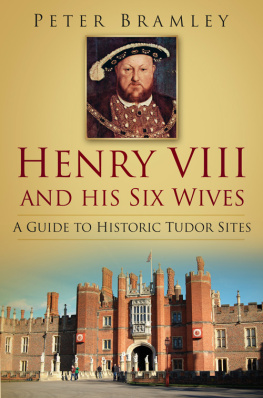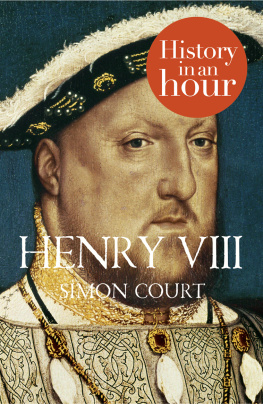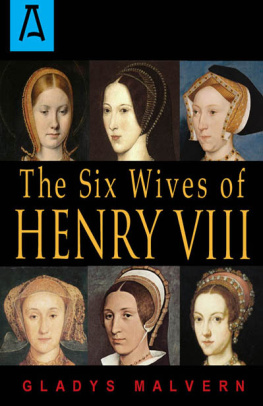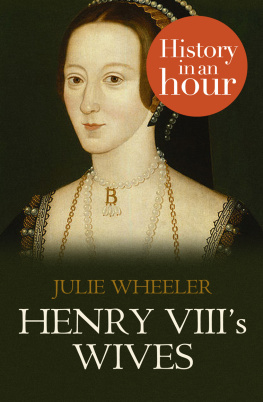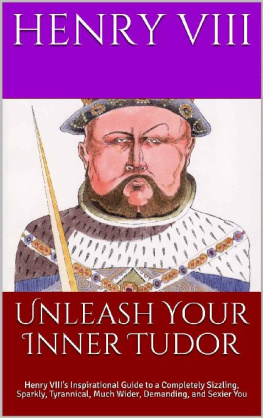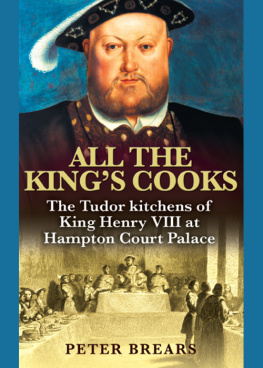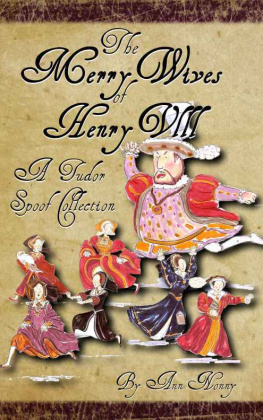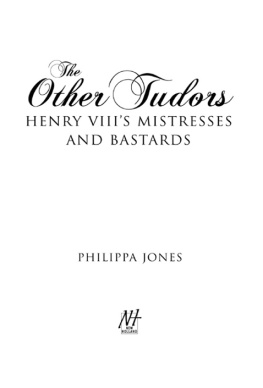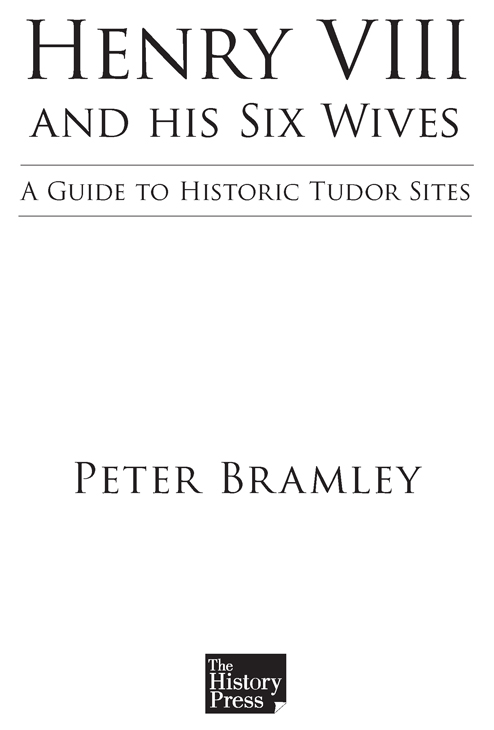
For my mother, Dorothy
C ONTENTS
The concept of this guide derives from the belief that the understanding and enjoyment of history can be enhanced by visiting the actual sites of key historical events, as well as the monuments or memorials to the people involved. Television documentaries on historical topics now routinely follow this approach, using on-location shots of appropriate sites. This guidebook is different because it focuses on one particular episode in English history Henry VIII and his six wives.
I could not have completed the task of researching and writing this book without the help of my family. My daughter, Lucy, has produced the maps and family trees and helped me with the digital photography, and my wife Sheila has provided a challenging ear throughout. Many thanks are due to Rachel Howkins, with whom, as always, it has been a pleasure to work.
All images are from my own collection unless otherwise credited. I am grateful to the following organisations for permission to reproduce images from their collections:
British Museum
British Library
Getty Images
National Portrait Gallery
Royal Collection Trust
All maps and family trees have been drawn by Lucy Bramley.
ONE
The saga of Henry VIII and his six wives is amongst the best known in English history. No other king comes close to this number of wives Edward III is next, with three. In his desperate twenty-eight-year search for a male heir, Henry turned England upside down, and heralded the English Reformation.
Even after 500 years, a considerable number of historic sites survive from these dark, turbulent times and can help to reconstruct the events and personalities of the period. Such sites occur in the form of houses, castles, churches and cathedrals, monasteries, plaques, obelisks and church monuments. The objective of this guide is to introduce the reader to the best of these, by providing for each site:
A short description of what there is to see.
A brief account of any events in the Tudor period that occurred there, and/or a biography of the person(s) commemorated, covering their role in the dramas.
Summary directions on how to find the site and other entry details. These directions are designed to complement modern road atlases.
A broad-brush star rating.
The guide covers those historic sites in England and Wales which I consider to be the most interesting and important. I have visited more than 200 sites over the last four years, selecting those to visit by consulting recent historical literature (see Bibliography), including the Pevsner and Arthur Mee county guides. My criteria for including sites in the guide are:
There must be something memorable to see to act as a focus of interest. So, churches where someone is known to have been buried but where no memorial has survived have been excluded.
The Tudor monarchs and their subjects were great builders and imposed themselves on both the urban and rural landscapes through houses of different designs in brick, stone and timber round the country. Examples of such properties are included, usually with a connection to our story.
Last but not least, each site must be accessible or at least visible to the public.
I have visited all the sites included in this guide at least once. In order to provide the reader with background for their visit to the site, the guide includes a summary of the key dates of the period, together with profiles of the main historical characters involved. The latter have been drawn from a number of sources, including the Oxford Dictionary of National Biography .
Please note that the scope of this book is limited to Henry VIII and his six wives; it does not cover all aspects of Henrys reign. Henry only visited the north of England once, when he travelled to York with Katherine Howard the Tudor power base was in the south so there are but nine sites to visit north of Sheffield. One final point: dates of birth were rarely recorded in Tudor times outside royalty; where possible I have included best-guess estimates.
TWO
THE WARS OF THE ROSES
The Tudor dynasty was very much a product of the Wars of the Roses the series of battles between the rival Plantagenet houses of Lancaster and York, stretching over thirty years from 1455 to 1487, in three clear phases. The wars arose because the four sons of Henry IV (who had usurped the throne in 1399) produced between them only one male heir the son of Henry V, who became Henry VI in 1422 on the premature death of his illustrious father.
Unfortunately, the young king had inherited his mothers mental instability so that, once his last uncle had died in 1447, the country descended into chaos as a vacuum developed at the centre of power. This ensured the loss of Normandy and Gascony and the end of the Hundred Years War, and allowed Richard, Duke of York to promote a rival claim to the throne, based on his descent from not only the fourth son of Edward III (the House of Lancaster was descended from the third son, John of Gaunt) but also through his mother, Anne Mortimer, from the second son Lionel, Duke of Clarence.
It was unclear in England at that time whether the throne could be inherited through a female. It had happened in the twelfth century, when Henry Is daughter Matilda had inherited, but that had led to a long civil war. Ever since then the Plantagenets had produced sons.
The first phase of the wars ended in 1461, when Edward, son of Richard, Duke of York, triumphed at the large scale and hard fought Battle of Towton, near York. Henry VI was not present at the battle, and was driven into hiding, leaving the throne to Edward IV who was supported by Warwick the Kingmaker. The second phase, from 146971, involved Warwick changing sides, driving Edward into exile and restoring Henry VI who was, by now, a complete puppet. However, in 1471 Edward returned from exile and decisively beat and killed Warwick at the Battle of Barnet, and then defeated the Lancastrian forces at Tewkesbury. Henry VI was murdered in the Tower, and that should have been it.
England enjoyed twelve years of relative peace, until Edward IV died after a fishing trip, just before his fortieth birthday. This instigated the third and final phase of the wars. Edward IV was succeeded by his son, Edward V, who was still only 12 years old, with his uncle Richard, Duke of Gloucester acting as Lord Protector. Richard could not resist the temptation, and in the summer of 1483 split the Yorkist party, usurped the throne as Richard III, and imprisoned his two nephews in the Tower. They disappeared from view and were never seen again.
After Henry VIs murder in 1471, because of the small size of the Lancastrian royal family, there were no mainstream candidates for their claim to the throne (Henry VIs son, Edward, had been killed at Tewkesbury). However, an alternative did exist through the Beauforts. In the 1360s, John of Gaunt produced four illegitimate children with his established mistress, Katherine Swynford. As adults, the children were legitimated by Richard II and the Pope in 1396. From John, the eldest son, was descended John Beaufort, Duke of Somerset (140844), whose only child was Lady Margaret Beaufort born in 1443.
Lady Margaret was, thus, a great heiress and was married, at 12 years of age, to Edmund Tudor, the eldest son of Owen Tudor and Katherine of Valois (mother to Henry VI). Katherine was somewhat fun-loving and had become involved with Owen, her Groom of the Wardrobe. Edmund had a younger brother, Jasper. Henry VI much favoured his half-brothers as his only living relatives. Edmund, keen to secure his wifes income, quickly ensured that Margaret was pregnant. In 1457 she gave birth to Henry at Pembroke Castle.
Next page
